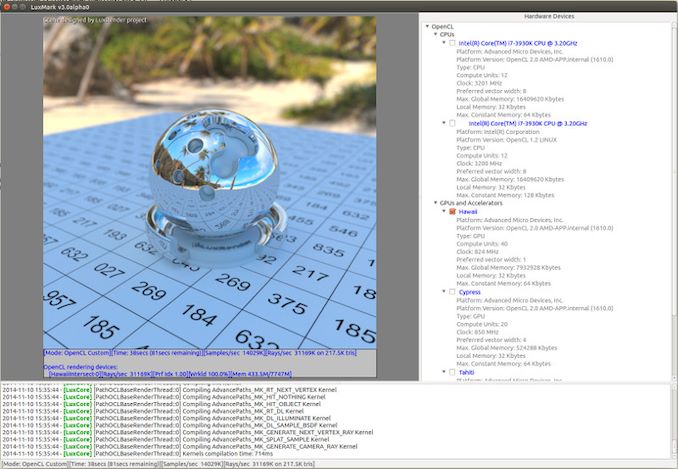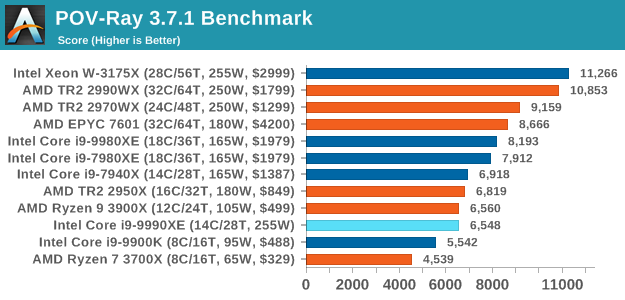The Intel Core i9-9990XE Review: All 14 Cores at 5.0 GHz
by Dr. Ian Cutress on October 28, 2019 10:00 AM ESTCPU Performance: Rendering Tests
Rendering is often a key target for processor workloads, lending itself to a professional environment. It comes in different formats as well, from 3D rendering through rasterization, such as games, or by ray tracing, and invokes the ability of the software to manage meshes, textures, collisions, aliasing, physics (in animations), and discarding unnecessary work. Most renderers offer CPU code paths, while a few use GPUs and select environments use FPGAs or dedicated ASICs. For big studios however, CPUs are still the hardware of choice.
All of our benchmark results can also be found in our benchmark engine, Bench.
Blender 2.79b: 3D Creation Suite
A high profile rendering tool, Blender is open-source allowing for massive amounts of configurability, and is used by a number of high-profile animation studios worldwide. The organization recently released a Blender benchmark package, a couple of weeks after we had narrowed our Blender test for our new suite, however their test can take over an hour. For our results, we run one of the sub-tests in that suite through the command line - a standard ‘bmw27’ scene in CPU only mode, and measure the time to complete the render.
Blender can be downloaded at https://www.blender.org/download/

Blender can take advantage of more cores, and whule the frequency of the 9990XE helps compared to the 7940X, it isn't enough to overtake 18-core hardware.
LuxMark v3.1: LuxRender via Different Code Paths
As stated at the top, there are many different ways to process rendering data: CPU, GPU, Accelerator, and others. On top of that, there are many frameworks and APIs in which to program, depending on how the software will be used. LuxMark, a benchmark developed using the LuxRender engine, offers several different scenes and APIs.

Taken from the Linux Version of LuxMark
In our test, we run the simple ‘Ball’ scene on both the C++ and OpenCL code paths, but in CPU mode. This scene starts with a rough render and slowly improves the quality over two minutes, giving a final result in what is essentially an average ‘kilorays per second’.

We see a slight regression in performance here compared to the 7940X, which is interesting. I wonder if that 2.4 GHz fixed mesh is a limiting factor.
POV-Ray 3.7.1: Ray Tracing
The Persistence of Vision ray tracing engine is another well-known benchmarking tool, which was in a state of relative hibernation until AMD released its Zen processors, to which suddenly both Intel and AMD were submitting code to the main branch of the open source project. For our test, we use the built-in benchmark for all-cores, called from the command line.
POV-Ray can be downloaded from http://www.povray.org/











145 Comments
View All Comments
DazFG - Tuesday, October 29, 2019 - link
Would like to see a average performance/Watt chart.abufrejoval - Tuesday, October 29, 2019 - link
The older 3Dmark physics tests don't scale to all available processor cores, so those numbers are misleading. My observation has been that the newer/more demanding the base benchmark, the wider the physics. So e.g. I doubt that Ice Storm actually scores beyond 4 physical cores, while I have seen the physics benchmark correllating to the DX12 graphics (keep forgetting the name) actually pushed all 18 cores in my workstation. I run HWinfo on a secondary screen to monitor what's happening on the system and it cleary reflects that most cores aren't used on these CPU-only physics tests.abufrejoval - Tuesday, October 29, 2019 - link
1.290V at 5 GHz all core may be "amazing" but it should really be "expected": Any chip that requires more voltage and thus power to push electrons through layer interconnects will fail the binning because of heat. And with every little part of 14 cores and their caches needing to qualify, it's easy to see how rare these are.DixonSoftwareSolutions - Tuesday, October 29, 2019 - link
I'm still holding out for the i9-9999XE.Hifihedgehog - Tuesday, October 29, 2019 - link
Agreeing to disagree with you, Ian, after seeing the benchmark results, I would hardly call this the slam dunk and beast it is made out to be. It is good in several benchmarks but it is highly specialized to the point I would argue the 9900KS would be the better choice of the two in nearly all cases for high frequency applications and the 3900X (and by extension 3950X) in multi-core applications. All in all, I am not really impressed and even less so with Threadripper 3000 and Cascade Lake on the verge of release.lejeczek - Tuesday, October 29, 2019 - link
Who cares about tests done on Windows? Who would bother with Chrome compilation on Windows?? Author(s) sees that increasingly more tests are being done with Open Source and clumsily tries to mimic that. But for those interested in real testing - go to phoronix.com and openbenchmarking.orgLots love, xxx.
Urufu - Tuesday, October 29, 2019 - link
Not interested because that's not the real world that people experience every day when using these microprocessors. My apologies for seeming abrupt.lejeczek - Thursday, October 31, 2019 - link
This certainly will sound abrupt - it's for that tiny little world and tiny people in it - the office?? Step outside for a moment and look at big data, clusters, HPC, all sort of servers & services, also academia! Linux & open source everywhere. Why?Might think... some media streaming, transcoding, codecs, etc. you might need that i9-9990XE beast in the office and for windows - sure if you click once here once there to run something - heavy duty transcoding that's Linux all around the clock.
But if one does only pure 'office' and thinks s/he must have this i9-9990XE - well these are the same sort of people who even today when it makes no financial sense whatsoever(do not mention this is not 'office' cpu), who have been happy to pay hefty taxes to Intel for years, those people will do it anyway, will waste money on it, as they do with anything else I'm sure.
But anyway, 'the office' stuff also we do with Linux, easy.
TEAMSWITCHER - Wednesday, October 30, 2019 - link
There is still a metric-sh*t-ton of software development that happens on Windows.MattZN - Tuesday, October 29, 2019 - link
Did you say 600W under full load? For a single CPU socket and only 14 cores? That isn't a wattage that will beget a limited market. That's a wattage that makes the chip D.O.A. No market. At all. Anywhere. Not for 'high frequency trading' or anything else.-Matt